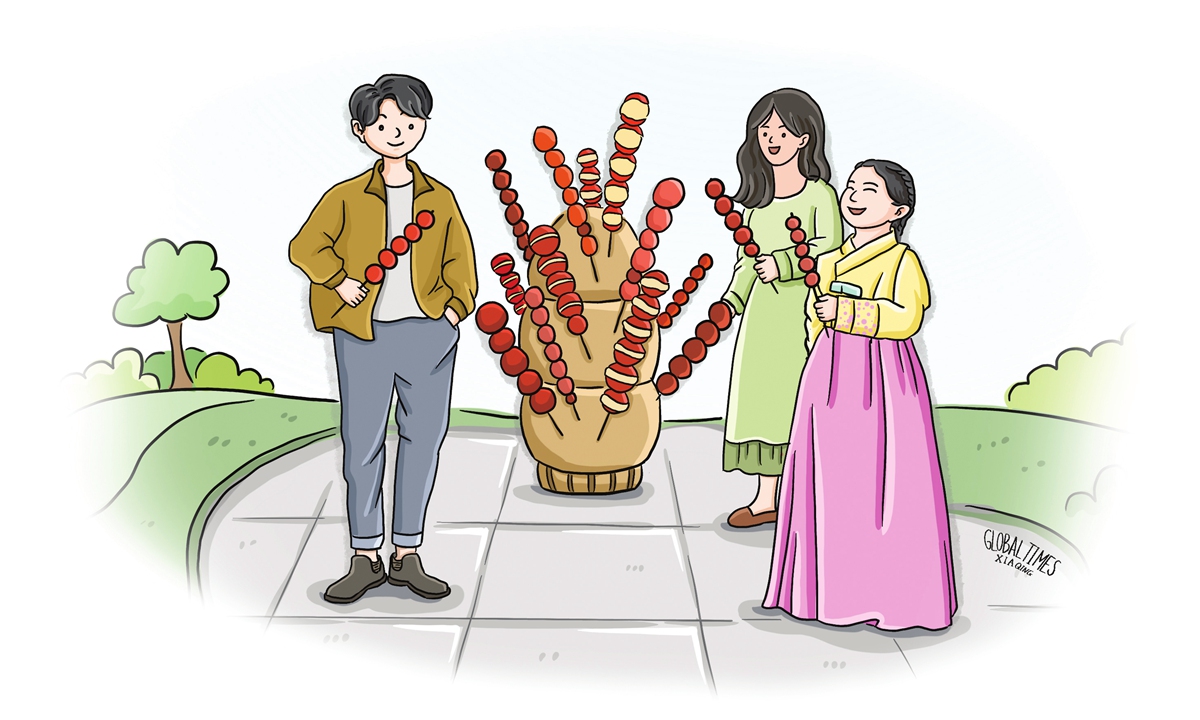
Illustration: Xia Qing/GT
In the era of globalization, coupled with the internet, any type of food can have its moment in unexpected places and in unexpected ways. Recently, tanghulu, a traditional Chinese snack of candied fruit, has become a big hit.
Surprisingly, in South Korea, the popularity of tanghulu has surpassed that of the country's traditional fried rice cakes. Reports show that as of October, the number of representative tanghulu brand stores in Korea has increased more than tenfold within one year. In some stores, as many as 200 skewers are sold per day. Tanghulu is also getting increasingly popular in European countries.
A food's popularity in a foreign country is often attributed to its own unique charm, and tanghulu is no exception. Not only does tanghulu provide a delightful taste experience, but it also offers consumers a surprise when mixed with different ingredients. In the northeastern region of China, there is a popular saying - anything can be made into tanghulu. Interesting combinations include candied pickled chicken feet or candied latiao, a spicy soy snack.
The popularity of tanghulu in South Korea is both unexpected and understandable. In addition to the charm of the food itself, the support of external conditions is also an important factor. The internet has played a crucial role in this aspect. Thanks to the internet, the tanghulu craze has taken over South Korea, captivating teenagers and young adults in a very short time.
The operating model of tanghulu stores is also one of the reasons for its rapid popularity in South Korea. Dalkom Wang Ga Tanghulu, Korea's biggest tanghulu chain, grew from around 50 stores in February to over 300 in August. Its online marketing has been very successful. Many young people are like to consume "popular foods." Malatang (a hot and spicy soupy dish of meat and vegetables) and milk tea also became popular overnight through a combination of online and offline marketing, despite previously being relatively unknown in South Korea.
The popularity of tanghulu in South Korea is also related to the country's social and geographical environment. A few years ago, Vietnamese rice noodles, pearl milk tea and malatang all enjoyed the same popularity as tanghulu is enjoying today. South Korea has a small land area, and the population in the capital area is relatively concentrated. Popular food in this area can quickly lead to nationwide trends. The popularity of tanghulu in South Korea also follows the pattern of how other Korean food gets popular.
The popularity of tanghulu in South Korea is not just a "note" in the rhythm of trends, but also has deeper social background, which also gives us some inspiration.
No matter how delicious the food is, it has to be adapted to the local customs, especially when going abroad, the eating habits of consumers in other countries should be taken into account. Some people may ask: there are so many delicious foods in China, why has tanghulu become so popular? In fact, this question leads onto another question. What is the key to success for a food to gain popularity overseas?
Tanghulu is originally of high sugar content, and has actually undergone a "localization" process in South Korea. According to local residents, the popular version of tanghulu in South Korea is slightly different from the tanghulu in China. In South Korea, it is covered with less sugar to cater to the dietary habits of South Korean consumers.
Localization is also a process of cultural colliding and blending. Before tanghulu became popular, South Koreans generally only eat fruit without adding anything else, not to mention sugar. Given the taste of young consumers, some more creative combinations have been launched, such as tanghulu made by stir-fried fried rice cake and sticky rice sausage. Integrating traditional Chinese food with South Korean eating habits and creative innovation, tanghulu brings not only a blending of taste but also culture.
China has a rich and splendid culture, of which food culture is an important part. Although tanghulu is a small part of this food culture, it is an embodiment of the vitality of the Chinese story. The popularity of tanghulu overseas is partly due to external conditions, but fundamentally it is the result of its own charm. To tell the Chinese story well, a good story is the foundation. China has never been short of good stories, and tanghulu is no exception, and many more stories will soon follow.
The author is a professor at Chongqing University. opinion@globaltimes.com.cn



